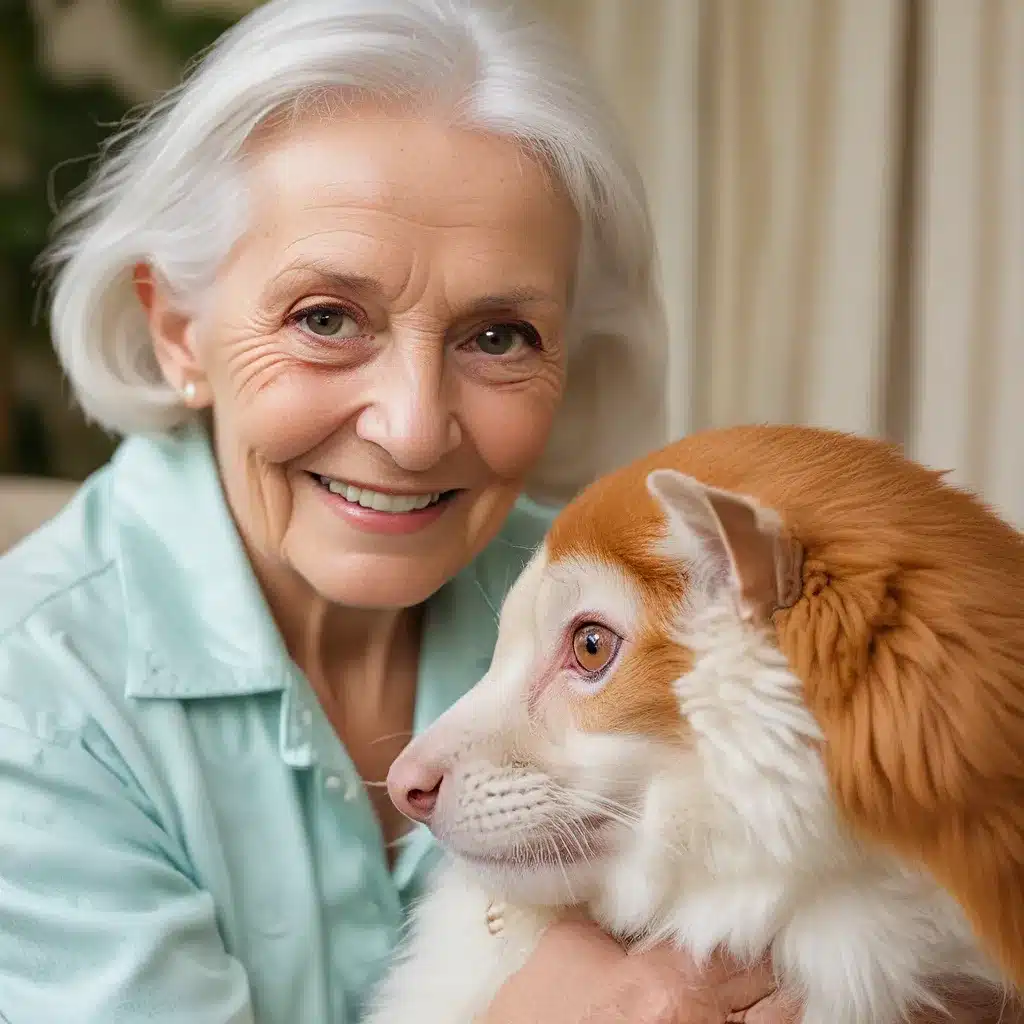
Feathered, Furry, and Fanatic: The Joys (and Challenges) of Owning Exotic Pets in Assisted Living
As I stroll through the halls of our cozy assisted living community, I can’t help but notice the flurry of activity. Residents are gathered around, giggling as a fluffy, four-legged friend trots by, pausing to give a few eager pets. In another corner, a vibrant parrot squawks out a cheerful greeting, much to the delight of the audience. It’s a scene that warms my heart – a testament to the power of incorporating exotic pets into elderly care.
You see, I’ve always been a bit of an animal enthusiast. So when my dear mother, Edith, decided to make the move to assisted living, I knew one non-negotiable: her beloved cockatiel, Chirpy, had to come along for the ride. And let me tell you, it’s been an adventure ever since.
The Benefits of Pets in Assisted Living
Edith’s eyes light up every time Chirpy flutters over to her outstretched hand. The simple act of caring for her feathered friend has done wonders for her mood and overall well-being. As it turns out, the research backs this up. Studies have shown that seniors with pets experience increased physical activity, more social interactions, and a general boost in their quality of life.
And Edith’s not the only one reaping the rewards. Across our assisted living community, we’ve witnessed the profound impact of incorporating furry, feathery, and even scaly companions. Take our resident cat, Whiskers, for example. This fluffy feline has a knack for snuggling up to those who need a little extra comfort, providing a calming presence for residents dealing with memory loss or anxiety.
Overcoming the Challenges
Of course, welcoming exotic pets into an assisted living setting isn’t without its challenges. When Edith first moved in, I’ll admit, I had a few reservations. Would Chirpy’s vocal tendencies disturb the other residents? What if he inadvertently escaped his cage and caused a ruckus? And let’s not forget the practical considerations, like who would be responsible for his daily care and cleaning.
Fortunately, the team at Golden Exotic Pets was there to guide us through the process. They worked closely with the assisted living staff to ensure Chirpy’s integration was a smooth one, providing tips on proper enclosure setup, feeding schedules, and even training the cockatiel to be a model resident.
Navigating the Rules and Regulations
As it turns out, most assisted living communities these days are quite pet-friendly. According to A Place for Mom, the majority of their partner communities allow residents to bring their furry, feathery, or scaly companions along. But of course, there are a few rules and regulations to keep in mind.
For starters, communities typically have guidelines around the types of pets allowed and the size restrictions. Edith’s cockatiel, being a relatively small bird, was an easy fit. But I can imagine a full-grown Great Dane might raise a few eyebrows. Additionally, there are often leash requirements for dogs, as well as restrictions on where the pets can roam within the community.
The Importance of Preparation
When it comes to incorporating exotic pets into assisted living, proper planning is key. As the experts at A Place for Mom advise, it’s crucial to consider factors like the pet’s temperament, any behavioral issues, and the senior’s ability to provide adequate care. After all, the last thing we want is for a beloved companion to cause disruptions or end up in an unfortunate situation.
Fortunately, Edith and Chirpy had already established a strong bond, and the cockatiel was well-trained and accustomed to a variety of environments. But for those residents who may be introducing a new pet to their assisted living lifestyle, it’s wise to consider obedience training or even a “Canine Good Citizen” certification to ensure a seamless transition.
The Joys of Pet Therapy
While Edith and Chirpy have certainly added a touch of whimsy to our assisted living community, they’re not the only furry friends gracing our halls. In fact, we’ve embraced the power of pet therapy, regularly inviting specially trained animals and their handlers to visit and interact with our residents.
And let me tell you, the results are nothing short of magical. I’ve seen residents with memory loss or cognitive decline instantly perk up, engaging in lively conversations and demonstrating a level of energy I wouldn’t have thought possible. According to the experts at A Place for Mom, even just 15 minutes of playtime with a gentle, well-behaved pet can work wonders, reducing stress and boosting serotonin levels.
The Importance of Contingency Planning
Of course, as with any aspect of assisted living, it’s crucial to have a plan in place for the unexpected. What happens if a resident can no longer provide adequate care for their pet? Or if a beloved companion passes away? These are the tough conversations we must be prepared to have.
As the team at A Place for Mom advises, it’s wise for residents to establish a pet trust or designate a trusted caregiver who can step in if needed. And for those who may be hesitant to bring a new pet into their lives, the option of community-owned animals or regular pet therapy visits can be a wonderful compromise.
Furry Friends Forevermore
As I reflect on Edith’s journey with Chirpy, I’m reminded of the profound impact these exotic pets can have on the lives of our elderly residents. From the pure joy of daily interactions to the calming presence they provide, these feathered, furry, and scaly companions have truly become an integral part of our assisted living community.
And you know what they say – a house isn’t a home without a pet. So, if you’re considering the next chapter for your loved one, I encourage you to explore the possibilities of incorporating exotic pets into their assisted living experience. Who knows – it just might be the start of a beautiful, lifelong friendship.

